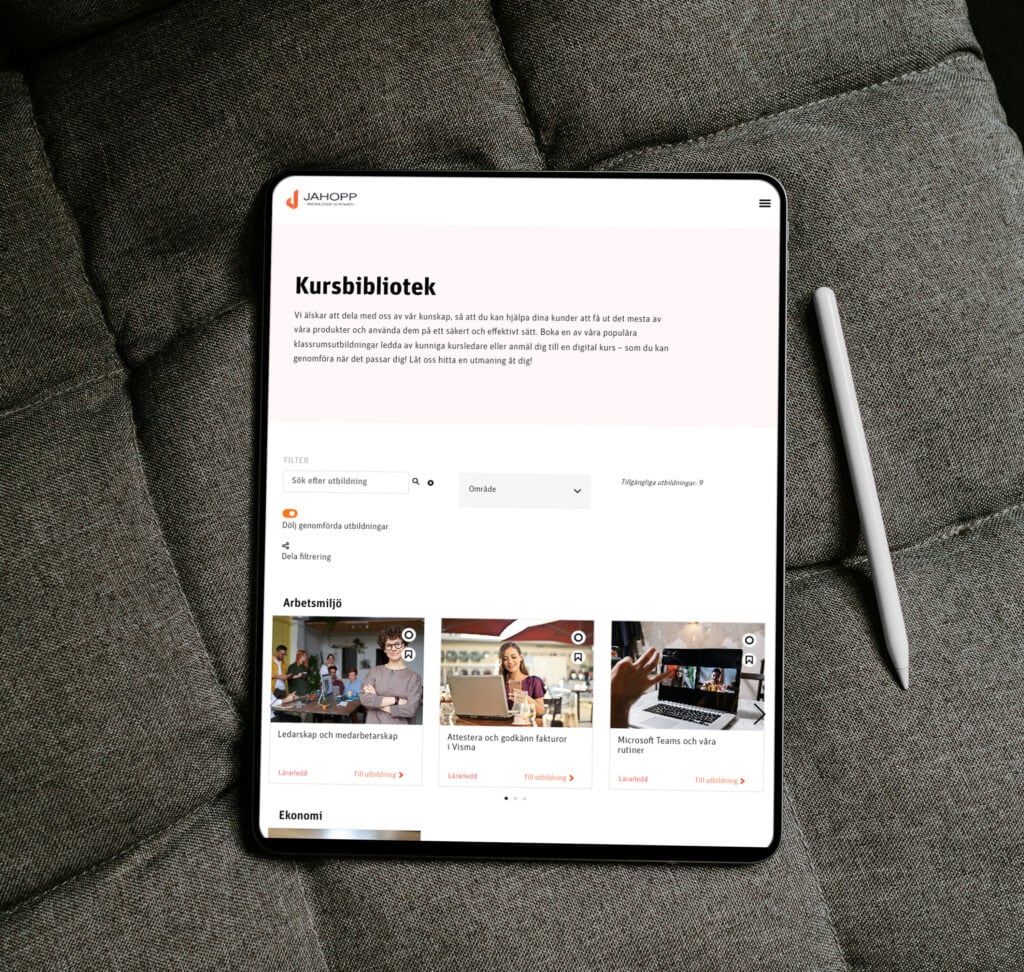UX/UI Design as the Key to Successful LMS Platforms
The need for effective and user-friendly LMS platforms (Learning Management Systems) is growing as digital education becomes increasingly common. To create a learning platform that both engages and inspires, thoughtful UX/UI design is essential. By putting the user’s needs at the center, you can develop a Swedish LMS that stands out on the market and offers a first-class learning experience. Natalie, our UX/UI design intern, shares her insights on how design principles can help create better educational platforms.
Can you tell us a bit about your education and what made you choose UX/UI design as your area of focus?
In the UX design program, we learn how to create user-friendly and appealing digital products such as websites and apps. UX (user experience) focuses on the overall user experience and how users interact with a product—understanding their needs, preferences, emotions, and behaviors to create satisfying and seamless experiences.
Meanwhile, UI (user interface) focuses on the visual aspects of the product—such as layout, colors, typography, and buttons—creating an interface that is both attractive and easy to use.
To achieve this, we study various design principles, research methods, user testing, prototyping, and tools used for creating designs.
Personally, I’ve always had a passion for creating, crafting, and solving problems using my creative talent since a young age. It wasn’t that long ago that I discovered my interest in developing innovative and effective solutions that make a product user-friendly in both function and design. Being able to work as a UX designer after my studies allows me to combine all these skills.
How do you see the possibility of using your experience from other platforms to contribute to the development of learning platforms?
My previous experience as a pharmacy technician has given me a strong foundation in customer service—understanding customer needs and being able to recommend products that meet those needs. Not only in medicine but also in technical aspects, such as helping customers navigate the company’s website and app when they struggled to understand them and needed assistance.
I’ve personally used learning platforms both as a student and as staff that failed to make things easy for users. I’ve experienced this myself but have also seen and heard the negative effects it can have on users when something isn’t user-friendly. This often leads to people not wanting to use the platform, which can result in routines and learning not being carried out as often as they should—simply because the platform wasn’t created with users as the starting point.
These qualities and experiences complement my new role and have given me a much broader understanding of users.
What fundamental principles of UX/UI design do you think are especially important when creating platforms in general?
Always keep users as the center of attention throughout the entire design process. Get to know your users on a deeper level—their needs, preferences, and behaviors—because they’re the ones who will be using the platform. They should be the foundation for any platform design. Use UX methods that not only simplify development but also save valuable time during the research phase. Test multiple times in the early stages to identify obstacles that users might face—not only technically but also in their overall experience. “Teamwork makes the dream work,” as I like to say. I’ve often been a lone wolf in my creative work, but I’ve come to realize how important teamwork is and how fruitful it can be to let ideas bounce around and evolve from different perspectives in the team, and then implement them into the final product.
What have you learned about understanding users’ needs and behaviors during your studies and previous projects?
I’ve learned that this is one of the key factors in creating a successful product. When you place users at the center of the entire project, you end up with a product that they themselves wanted—making it far more likely that they’ll actually use it. Another thing I’ve realized is that you can’t assume users will understand something just because we as UX designers do. It’s not always obvious. We all have different behaviors and learned routines, so you need to “humble yourself,” set your ego aside, and focus on the people who are actually going to use the product. With this mindset, I’ve learned to move beyond my own assumptions and focus on solving real problems for real people.
Can you give examples of platforms or websites you think offer a really good user experience, and why?
I’d say Duolingo. I’ve used it for quite some time and think the user experience is excellent because they use gamification to make learning fun and engaging. The user flow (navigation) is simple to understand and move through. They’ve broken the learning into small, manageable steps, which makes it easier to follow without feeling overwhelmed. To keep users motivated, they provide instant feedback and rewards for progress. They’ve succeeded in creating a platform that’s easy and enjoyable for users of all ages and experience levels to reach their goals.
What are you looking forward to learning during your internship here?
I want to develop even further in understanding our users’ needs on a deeper level and be able to apply that to the development of learning platforms. I want to refine and strengthen my research and design skills to deliver a more user-friendly and user-centered product. I also want to grow into a better team player in both collaboration and communication. In short, I aim to exceed our clients’ expectations by helping create a platform that engages and inspires users to keep learning.
Final thoughts
Natalie’s thoughts and experiences clearly show how UX/UI design can improve LMS platforms and other digital tools. By keeping users in focus, testing continuously, and creating engaging design, we can develop a learning platform that inspires and motivates. This isn’t just important for the user experience—it’s also key to building a Swedish LMS that stands out in the market.

